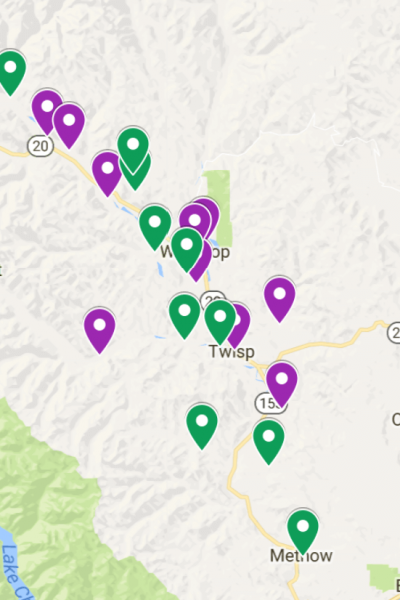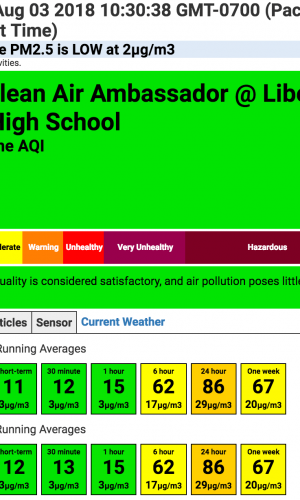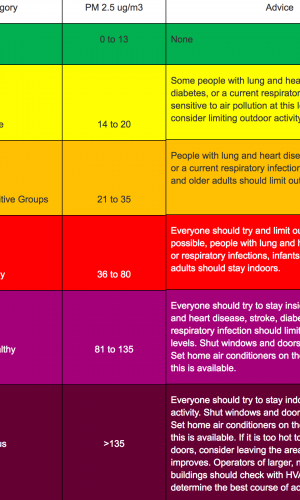Clean Air Methow manages the Clean Air Ambassador Program. 22 air quality sensors have been placed throughout the valley. These low-cost sensors report real-time particulate matter pollution or PM2.5, the main component of smoke, our year-round priority pollutant of concern. Air quality measurements from these sensors are reported every eighty seconds and displayed in a google maps interface at www.purpleair.com.
During wildfire season, we encourage you to check out the map at purpleair.com to locate clean air relatively nearby as possible. For those with known sensitivities to smoke, including infants and children, adults over 65, pregnant women, and anyone with heart or lung conditions, we hope this tool will enable finding some “breathing room” and the ability to get outdoors or relocate to sleep with family or friends in safer air conditions.
The Clean Air Project seeks to work in partnership with community members, other nonprofits and organizations, government, schools, etc. in a collaborative approach to solutions. We incorporate both learning and teaching approaches to improving air quality, asking what needs and questions the community has while sharing impactful information about air quality and health. We disseminate and publish ideas, tools, and best practices to the rural west, contributing on local, regional and national scales to the challenges of poor air quality. We ensure big and lasting impact of our work through bringing attention to the severity of rural air quality issues and advocating effective environmental and public health policy changes.

-Launched the Clean Air Ambassador Program with 22 businesses, individuals, schools, and municipalities hosting “Purple Air” low-cost air quality sensors. This network of clean air stewards provides a highly comprehensive map of air quality across the 60 miles of river valley and drainages where people live and work.
-Indoor air sampling for schools, businesses, and community members
-Ongoing community outreach and education about air quality issues and solutions (radio ads, newspaper articles and editorials, flyers, Facebook, blog posts)
-Input to policy improvements to reduce prescribed burn smoke including recommendations on communicating to the public, establishing a smoke complaint documentation process, and incorporation of information from other air quality sensors such as the Purple Air network.
We are seeking additional participation and funding for this exciting project!
- Become an Ambassador! Being an Ambassador and hosting a sensor requires nothing more than an enthusiasm for promoting clean air in the valley and a commitment to our simple steps to ensure high data quality from your device. If you want to learn more please contact MVCC’s Air and Climate Lead, Liz Walker liz@mvcitizens.org Depending on your location, we may have a sensor already secured for you to host, or we may ask that you purchase your own sensor to participate.
- Give! We have so much more we can accomplish with this project sponsored by the Methow Valley Citizens Council. Please specifically indicate you’d like to support the work of the Methow Valley Clean Air Project when making your donation to this 501c3 non-profit by check to PO Box 774 Twisp.
- Tell a friend! If you think this is a cool project or know someone who might, please spread the word. If you’d like to keep up on activities of Clean Air Methow, please like our Facebook page.
Important to note is that as air pollution levels increase, these low-cost sensors are known to consistently overestimate particulate levels up to two-fold. We are working to develop an appropriate “correction-factor” by co-locating sensors with our Washington State Ecology local nephelometers and the federal reference monitor in Omak to better understand how the sensor readings track with these more sophisticated devices across varying temperatures and humidity.
Another notable feature is that the value shown on the purple air map is a real-time air quality index that changes every eighty seconds. Concentrations of particulate matter (micrograms/m3 of air) are translated into an air quality index number and associated health risk color according to the EPA AQI. If you click on a particular sensor, you can see a variety of data displays of recent air quality information from that instrument. Note that the color-coded system to communicate health risk was developed by EPA for 24 hour exposures. Understanding the health effects of acute, or short-term exposures to heavy air pollution such as from wildfire or prescribed burn smoke is an important area of active research.
A note about health effects of PM2.5 and smoke
While the EPA’s color-coded air quality rating system was developed to provide guidance for precautions to take to protect your health, everyone is different. You may not need an orange or red day to begin experiencing symptoms. We encourage you to pay attention to your body in poor air quality conditions: if you are bothered by the smoke, especially if you are experiencing wheezing or difficulty breathing, try to find or create clean air and seek medical attention. Indoor air purifiers with true HEPA filters remove 99.75% of particulate matter .3 microns or smaller and can be extremely effective in creating safe breathing conditions even in heavy outdoor smoke. If you must spend time outside, we encourage you to wear a N95 or N100 mask. While studies conclusively show poor health outcomes from chronic (i.e. months to years) exposures to poor air quality, the effects of acute (i.e. days to weeks) exposures to smoke, such as that from wildfires, have not been well characterized. However, increases in emergency room visits and asthma attacks are strongly correlated with air pollution episodes. Bottom line, if you have the ability to reduce your exposure to smoke, do it! More information about the health risks of smoke can be found at the following links:
Health Information Washington Department of Health
Sign up for action alerts from the Methow Valley Clean Air Project below:

![purple air[7434] purple air[7434]](https://mvcitizens.org/wp-content/uploads/2018/08/purple-air7434-300x400.jpg)
![pair 11 am[7433] pair 11 am[7433]](https://mvcitizens.org/wp-content/uploads/2018/08/pair-11-am7433-300x400.jpg)
![2018.08.03 12 pm[7432] 2018.08.03 12 pm[7432]](https://mvcitizens.org/wp-content/uploads/2018/08/2018.08.03-12-pm7432-300x400.jpg)

